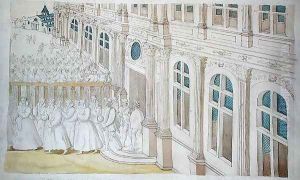Nicolas Houel Paintings
Nicolas Houel was a French apothecary, philanthropist, and enigmatic figure in the art world of the 16th century, whose life spanned from around 1520 to 1587. Although not primarily known as an artist, Houel's contributions to the arts and society during the Renaissance period were significant, especially in relation to his work with the poor and his efforts in the promotion of public health.
Houel was born in a period of great social, political, and cultural changes in Europe. The Renaissance was in full bloom, and Paris, where Houel lived and worked, was a center for innovation and creativity. Houel was not only an apothecary—a profession that involved preparing and selling medicines, which at the time was closely connected to the natural sciences and the arts—but he was also deeply involved in the intellectual and artistic movements of his day.
As an apothecary, Houel had extensive knowledge of herbs and drugs, which was considered both a practical and scholarly pursuit. His work would have required an understanding of botany, chemistry, and medicine, linking him to the broader scientific inquiries of the Renaissance. Houel's shop would have been a place of learning and discussion, where ideas about health, science, and perhaps even art circulated freely among the educated classes.
Beyond his professional life, Nicolas Houel was known for his humanitarian efforts. He was deeply concerned with the well-being of the poor and took concrete steps to aid them. In 1569, he founded the 'Maison de la Charité Chrétienne' (House of Christian Charity) in Paris, which was an institution aimed at caring for the sick and providing for the education of orphaned children. This endeavor reflected the Renaissance ideals of philanthropy and the betterment of society.
Houel was also an author and wrote a treatise titled 'La science et pratique de l'agriculture' (The Science and Practice of Agriculture), which underscores his interest in the practical application of knowledge for the improvement of society. This work indicated his belief in the value of agricultural knowledge and its impact on public health and well-being.
Although Houel was not an artist himself, he was associated with the arts through his membership in the confraternity of Saint Luke, a guild that included painters, sculptors, and engravers. His connections with this guild suggest that he was an art patron and had close ties with artists of the day.
Nicolas Houel's legacy is dual: he is remembered for his dedication to public health and welfare through his charitable work, and he is also recognized for his engagement with the intellectual and artistic community of Renaissance Paris. His life and pursuits embody the spirit of the Renaissance man, deeply invested in the betterment of society through the application of knowledge across various fields.
